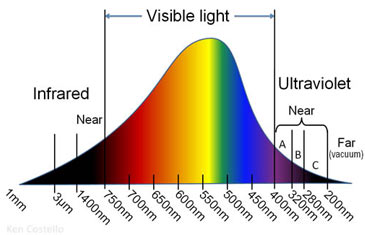Streamers of sunlight filtering through a clear blue sea are more than just a pretty sight -- they’re the power source for almost all the life in the oceans.
Three forms of solar energy hit the oceans: infrared, visible, and ultraviolet. Some of this energy is reflected back into space, but most of it penetrates the surface. In clear, calm waters under a cloud-free sky, some of the sunlight can travel up to a few hundred feet down.
 Graph showing the wavelengths of infared, visible, and ultraviolet light. Credit: National Oceanic and Atmospheric Administration
Graph showing the wavelengths of infared, visible, and ultraviolet light. Credit: National Oceanic and Atmospheric AdministrationThe infrared energy is invisible to the eye, but we feel it as heat. Most of the Sun’s infrared energy is absorbed by water vapor in the atmosphere. The fraction that hits the surface is absorbed in the top few feet of the water, heating the ocean surface.
Most of the energy that penetrates the atmosphere is visible light -- what we see with our eyes. This, too, is converted to heat as it enters the water.
But some of this energy is absorbed by microscopic plants that float near the surface, or by larger plants rooted in shallow waters. They combine the sunlight with carbon dioxide, water, and nutrients in a process known as photosynthesis. This process creates the food that sustains the plants. It also produces oxygen, which is released into the water -- and some of which eventually escapes into the atmosphere.
Small animals eat these plants. They, in turn, are eaten by larger animals, all the way up through the food chain. So the sunlight provides the energy to sustain most of the life in the oceans.
We’ll talk about ultraviolet energy on our next program.

